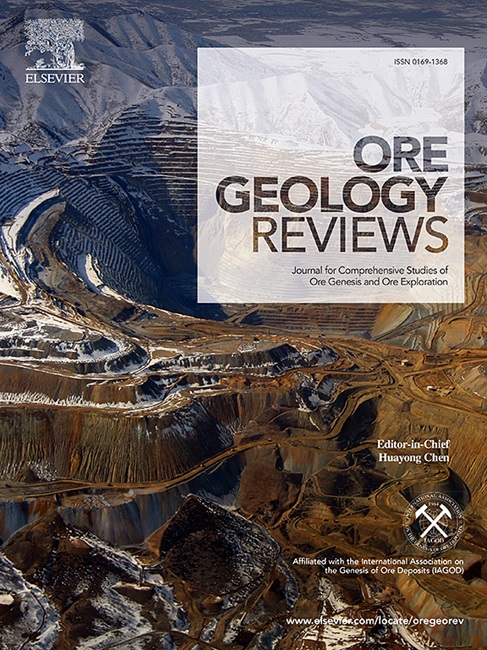马尾山铅锌矿床成因及其对闪锌矿中关键金属(Cd、Ga、In)成矿作用的控制
IF 3.2
2区 地球科学
Q1 GEOLOGY
引用次数: 0
摘要
矽卡岩型Pb(铅)-Zn(锌)多金属矿床不仅是Pb、Zn的重要来源,也是Cd、In、Ge、Ga等关键金属的重要来源。在中国东部长江中下游成矿带宣城矿区内发现了大量矽卡岩型(或岩浆-热液)铅锌矿床。然而,与该区已有文献记载的斑岩型Cu-Au、矽卡岩型Cu-W和Cu-Mo矿床相比,这些铅锌矿床的研究还不够充分。此外,对铅锌矿床中关键金属形态的控制和性质也知之甚少,包括对这些铅锌体系中替代过程和这些金属来源的识别。马尾山矿床与邻近的乔麦山矿床之间的潜在成因联系也不确定,一些研究认为马尾山矿床是乔麦山夕卡岩体系的远端部分,而另一些研究认为它们是独立的夕卡岩体系。本研究利用马尾山石榴石原位U-Pb测年获得的矿化时间新证据解决了这些问题。该石榴石的下截距U-Pb年龄为132.3±1.4 Ma,与近端马尾山石英闪长岩的锆石U-Pb年龄(132.4±0.9 Ma)一致。结合矿床内部蚀变和矿化的空间关系,强烈表明近端石英闪长岩与马尾山矿床的形成有成因关系,该矿床不是乔麦山矽卡岩体系的远端表现。马尾山闪锌矿还含有高含量的关键金属Cd [3480-5107 ppm]、In (78.3-407 ppm)和Ga (22.4-348 ppm)。这种闪锌矿中的Cd2+是通过直接取代Zn2+而结合到矿物晶格中的,而三种闪锌矿中In3+的均匀浓度表明,这些闪锌矿中的In3+是通过吸附或捕获均匀的in纳米颗粒而结合的。马尾山闪锌矿中的Ga3+主要是Cu+取代2Zn2+的耦合取代作用,而Ag+ + Ga3+取代2Zn2+的耦合取代作用也参与了Ga进入Sp2闪锌矿的过程。马尾山矿床硫化物硫同位素δ34S范围较窄(δ34S范围为4.9‰~ 8.3‰,平均5.8‰),结合新发现的石榴石微量元素数据和元素图,表明形成马尾山的金属和流体主要来源于近端石英闪长岩。这些硫同位素数据还表明,少量的金属或硫来自周围的岩石。这些数据为宣城矿区铅锌矿床的关键金属成矿提供了新的认识,该区区域褶皱富集成矿流体产生了139ma Cu-W和132ma Pb-Zn成矿事件,表明该构造带是宣城及其他具有类似特征的地区今后勘查的理想区域。本文章由计算机程序翻译,如有差异,请以英文原文为准。

Genesis of the Maweishan Pb–Zn deposit, eastern China and controls on the distribution and formation of sphalerite-hosted critical metal (Cd, Ga, and In) mineralization
Skarn-type Pb (lead)–Zn (zinc) polymetallic deposits are not only important sources of Pb and Zn but also critical metals such as Cd, In, Ge, and Ga. Significant numbers of skarn-type (or magmato-hydrothermal) Pb–Zn deposits have been identified within the Xuancheng ore district of the Middle and Lower Yangtze River metallogenic belt of eastern China. However, these Pb–Zn deposits are understudied compared to the well-documented porphyry-type Cu–Au, skarn-type Cu–W and Cu–Mo deposits within this district. In addition, the controls and nature of the deportment of critical metals within Pb–Zn deposits also remain poorly constrained, including identification of substitution processes and the sources of these metals within these Pb-Zn systems. The potential genetic link between the Maweishan deposit and the adjacent Qiaomaishan deposit also remains uncertain, with some research considering that the Maweishan deposit is a distal part of the Qiaomaishan skarn system whereas other research suggests that these are independent skarn systems. This study addresses these issues using new evidence of the timing of mineralization obtained by the in-situ U–Pb dating of the garnet from the Maweishan deposit. This garnet yields a well-defined lower-intercept U–Pb age of 132.3 ± 1.4 Ma, consistent with a zircon U–Pb age for the proximal Maweishan quartz diorite (132.4 ± 0.9 Ma). This, combined with the spatial relationships of alteration and mineralization within the deposit, strongly suggests that the proximal quartz diorite is genetically related to the formation of the Maweishan deposit and this deposit is not a distal manifestation of the Qiaomaishan skarn system. Sphalerite from the Maweishan deposit also contains high levels of the critical metals Cd [3480–5107 parts per million (ppm)], In (78.3–407 ppm) and Ga (22.4–348 ppm). The Cd2+ within this sphalerite was incorporated into the mineral lattice by direct substitution for Zn2+, whereas the uniform concentrations of In3+ in all three types of sphalerites is indicative of incorporation by the adsorption or capture of homogeneous In nanoparticles. The Ga3+ within the Maweishan deposit was predominantly incorporated into sphalerite as a result of coupled substitution with Cu+ replacing 2Zn2+, with the Ag+ + Ga3+ coupled substitution for 2Zn2+ also involved in the incorporation of Ga into the Sp2 sphalerite. The narrow range of sulfur isotopes (δ34S from 4.9 ‰ to 8.3 ‰, average of 5.8 ‰) for sulfides within the Maweishan deposit combined with the new garnet trace element data and elemental maps presented in this study suggests that the metals and fluids that formed the Maweishan were primarily derived primarily from the proximal quartz diorite. These sulfur isotopic data also indicate that a small amount of metals or sulfur were derived from the surrounding country rocks. These data provide new insights into critical metal mineralization associated with Pb–Zn deposits in the Xuancheng ore district, where regional folding concentrated ore-forming fluids that generated both 139 Ma Cu–W and 132 Ma Pb–Zn mineralization events, indicating that this structural zone is an ideal area for future exploration within the Xuancheng district and in other areas with similar characteristics.
求助全文
通过发布文献求助,成功后即可免费获取论文全文。
去求助
来源期刊

Ore Geology Reviews
地学-地质学
CiteScore
6.50
自引率
27.30%
发文量
546
审稿时长
22.9 weeks
期刊介绍:
Ore Geology Reviews aims to familiarize all earth scientists with recent advances in a number of interconnected disciplines related to the study of, and search for, ore deposits. The reviews range from brief to longer contributions, but the journal preferentially publishes manuscripts that fill the niche between the commonly shorter journal articles and the comprehensive book coverages, and thus has a special appeal to many authors and readers.
 求助内容:
求助内容: 应助结果提醒方式:
应助结果提醒方式:


